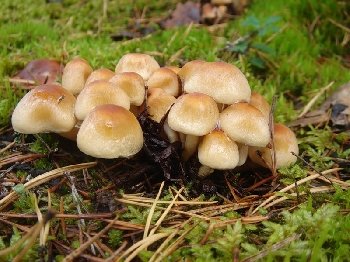Hypholoma head-shaped (Hypholoma capnoides)
- Diviżjoni: Basidiomycota (Basidiomycetes)
- Subdiviżjoni: Agaricomycotina (Agaricomycetes)
- Klassi: Agaricomycetes (Agaricomycetes)
- Sottoklassi: Agaricomycetidae (Agaricomycetes)
- Ordni: Agaricales (Agaric jew Lamellar)
- Familja: Strophariaceae (Strophariaceae)
- Ġeneru: Hypholoma (Hyfoloma)
- Tip: Hypholoma capnoides (Hypholoma head-shaped)
- Nematoloma capnoides

Kpiepel: in young mushrooms, the cap is convex, in mature mushrooms it becomes prostrate. The cap diameter reaches 8 cm. The surface of the cap is completely smooth. The color of the surface practically does not change during the ripening of the fungus, it remains yellowish-brown with shades of green. The bell cap has a blunt tubercle in the center. In mature mushrooms, rusty-brown spots may appear on the hat.
Rekords: приросшие, у молодых грибов бледного цвета, затем меняют окрас на дымчато-серый.
Sieq: the hollow leg has a curved shape. The height of the stem is up to 10 cm. The thickness is only 0,5-1 cm. In the upper part, the stem has a lighter color, which passes to the base in a rusty-brown color. The surface of the leg is silky smooth. There are no rings on the stem, but in many specimens you can see pieces of a private bedspread, which sometimes remain along the edges of the cap.
Polpa: thin, brittle, whitish color. At the base of the stem, the flesh is brown. The taste is a little bitter. The smell is practically absent.
Trab tal-ispori: gray purple.
L-ikel: conditionally edible mushroom of the fourth category of nutritional value. Only mushroom caps that are suitable for drying can be eaten. The legs of the mushroom are often hard and woody, like other mushrooms.
Xebh: Hyfoloma head-shaped (Nematoloma capnoides) outwardly resembles a sulfur-yellow honey agaric, which differs in the color of the plates. At the honey agaric, the plates are first sulfur-yellow, and then greenish. It is worth noting that sulfur-yellow honey agaric is a poisonous mushroom. It also resembles a summer honey agaric, which is not dangerous.
Ifrex: not common, grows in groups in pine meadows from June to October. Sometimes found in places of debarking wood and on heaps of bark. The fruiting period can stretch until the beginning of winter. Even with frosts in the forest, you can find frozen mushroom caps that can be consumed fried. In severe frosts, frozen mushrooms are stored for a long time.









